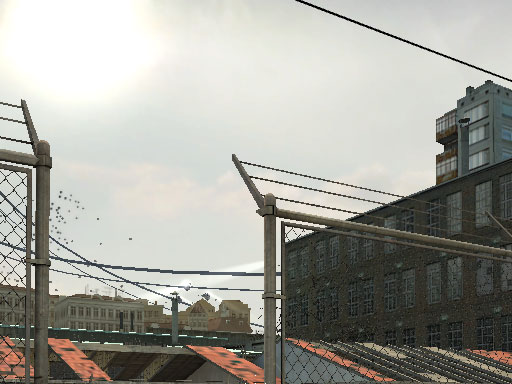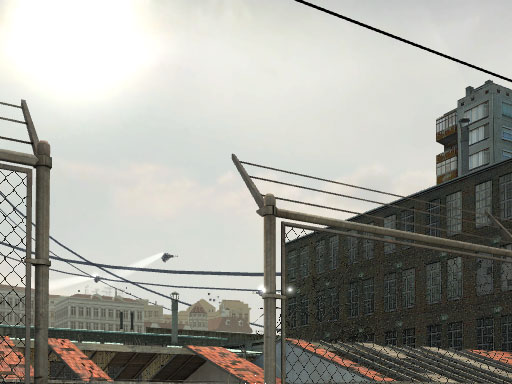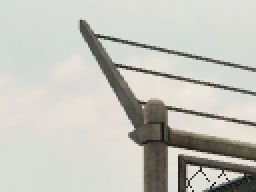Half Life 2 GPU Roundup Part 1 - DirectX 9 Shootout
by Anand Lal Shimpi on November 17, 2004 11:22 AM EST- Posted in
- GPUs
Turning on Antialiasing
Quite possibly the biggest difference between Half Life 2 and Doom 3 (other than the fact that Half Life 2 is infinitely brighter) is that aliasing is far more pronounced in Half Life 2 than in Doom 3. The aliasing isn’t overwhelming and at resolutions of 1280 x 1024 and above it is minimized relatively well, but it’s still something we’d like to get rid of.
Enabling 2X AA proved to help somewhat but not as much as we would have liked, thus we turned our attention to enabling 4X AA on the cards compared here today. We haven't included any screenshots in line because they would have to be scaled down to fit on this page, so we are offering a zip file of all of the screenshots we are talking about here.
Our first test was 1024 x 768 with 4X AA enabled - we found that while 1024 x 768 with 4X AA enabled gave us some very solid image quality, we preferred playing at 1280 x 1024 without AA. Most cards offered slightly reduced performance playing at 1280 x 1024 vs. 1024 x 768 with 4X AA.
Next we looked at 1280 x 1024 with 4X AA enabled - here we found that 1280 x 1024 with 4X AA enabled was a good alternative to 1600 x 1200, however with most cards 1600 x 1200 ran faster than 1280 x 1024 with 4X AA enabled. In the end the choice here comes down to whether your monitor supports 1600 x 1200 or not; if it does, then by all means, 1600 x 1200 is the resolution to run at, otherwise 1280 x 1024 with 4X AA is a good alternative.
Finally we have 1600 x 1200 with 4X AA enabled - this is truly a beautiful setup and while you can definitely play it on even a GeForce 6800, it is best paired with a GeForce 6800 Ultra or Radeon X800 XT or better yet, two GeForce 6800 Ultras. You don’t get a much better looking game than Half Life 2 at 1600 x 1200 with 4X AA enabled.
So interestingly enough, although Half Life 2 definitely appreciates antialiasing being enabled, in reality the performance hit is just not worth the resulting gains in image quality – especially when compared to just cranking up the resolution and leaving AA disabled. For those of you that are interested in enabling AA anyway, we have provided some AA benchmarks on the next pages. But before we get to the benchmarks let's have a look at AA image quality.
First let's look at both ATI and NVIDIA with everything disabled:

Antialiasing Disabled on ATI

Antialiasing Disabled on NVIDIA
So far so good, both ATI and NVIDIA look identical (except for the birds flying around in the background, but regardless of how many breadcrumbs we left out they would not stay still).
Now let's turn on 4X AA:

4X AA Enabled on ATI

4X AA Enabled on NVIDIA
You can immediately see the benefit of having AA turned on in Half Life 2 (these screenshots were taken at 1024 x 768), but let's zoom in for a closer look to see if either card is doing a better job:
ATI (4X AA - 200% Zoom) |
NVIDIA (4X AA - 200% Zoom) |
 |
 |
From the screenshots above it is tough to tell the difference between the two competitors. It looks like NVIDIA may have a slightly more blurry AA implementation than ATI, but it is really tough to tell the two apart.










79 Comments
View All Comments
araczynski - Thursday, November 18, 2004 - link
yawn, i'm too busy enjoy the game (6800gt) to read the article and/or care which card is better :) i'm playing at 1600x1200 0AA/4AF (2.4@3.3/1GB) and have absolutely no complaints, other then knowing that the game will eventually end :(Jeff7181 - Thursday, November 18, 2004 - link
#57... poorly :)blckgrffn - Thursday, November 18, 2004 - link
I would also like to to see how the 9200/9000 series Radeons perform too, and if you have extra time, the 8500/9100.Again, Thanks!
Jeff7181 - Thursday, November 18, 2004 - link
#16... that's correct, although the only REAL observation that needs to be made is that Half Life 2 makes heavy use of pixel shaders which is very GPU dependant, and GPU's are just now growing the required testicles to process those shaders :)blckgrffn - Thursday, November 18, 2004 - link
Anand -I would like to see how the 6600 performs. As an 8 pipe card, it should perform better than the 9600xt and a little under a 9700 Pro, but it would be interesting to see if that is true. It is a great budget PCIe card along with the x700.
Thanks!
Nat
eva2000 - Thursday, November 18, 2004 - link
nice review downloaded your demos to run on AMD64 3700+ @ 12x 222 = 2664mhz with 1GB BH-5 @ 222mhz 2-2-2-6 1T and Powercolor X800XT PE @ 520/560 and all demo results were within 3-4fps of the reviews :)Live - Thursday, November 18, 2004 - link
Good reading as always. Would like to see minimum FPS tough. I find it very important to see how low the cards drop when stressed. You can't see that with only average FPS.housecat - Wednesday, November 17, 2004 - link
So... wheres the Nvidia SLI versus ATI results??Muwahahaha.
Avalon - Wednesday, November 17, 2004 - link
Hey Anand, I have an interesting request. Could you try Rivatuner on your 6800, unlock its pipes, and then bench it again? :PJust kidding. Actually, I'm glad you've confirmed what I've been thinking...that AF hasn't been doing much for me. Since I'm running on a lowly 9700, I think I'll just turn it off now, and enjoy a nice speed boost.
PrinceGaz - Wednesday, November 17, 2004 - link
How about throwing a GF 5600 and maybe even a GF 5200 in as well for part 2, as an awful lot of people have them. Ultra versions of either if you prefer.I don't have one of them myself as I'm still using a Ti4200, but it would be interesting to see how they stacked up in the DX8 codepath against the Ti4600 you are planning to test. And it should be worth a giggle to see just how "fast" the 5600 or 5200 can manage the DX9 codepath :)
Thanks to the resolution scaling-graphs this review included and how the fastest cards were generally CPU limited with that A64 4000+ when the resolution was dropped to 1024x768, I'm not sure how much a CPU scaling article for part 3 will show that can't already be quite accurately guesstimated from how different CPUs generally tend to perform in games. But a comparison of the Athlon 64 4000+, against an Athlon XP, a Prescott, a Northwood, and if time permits a fast P3, Duron and Celeron also, would be great.